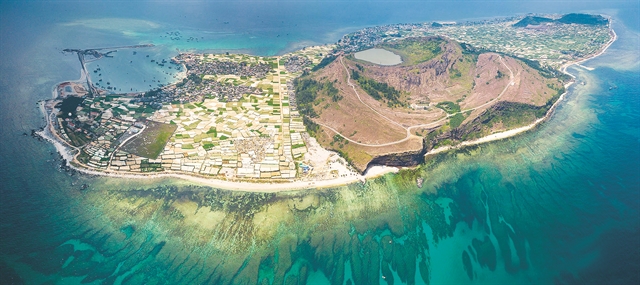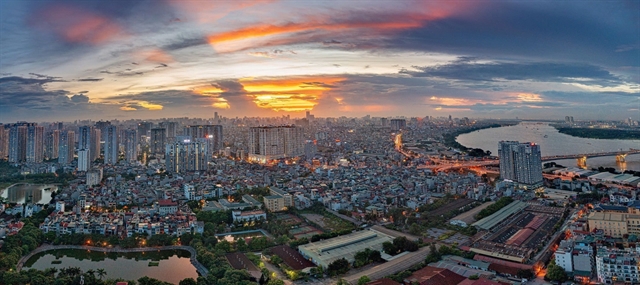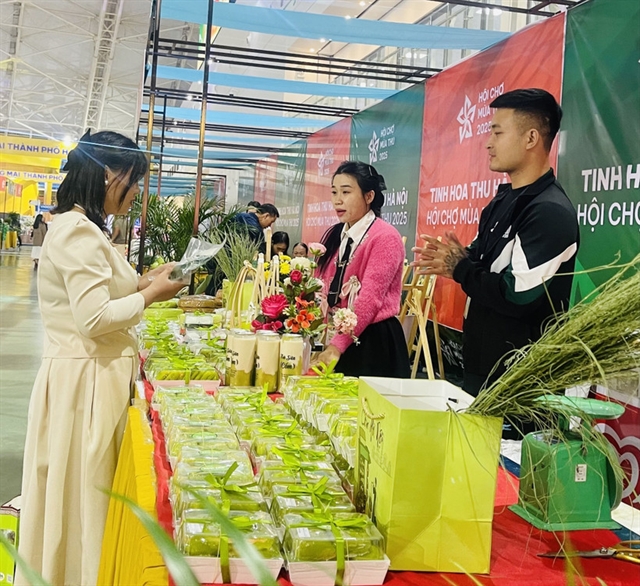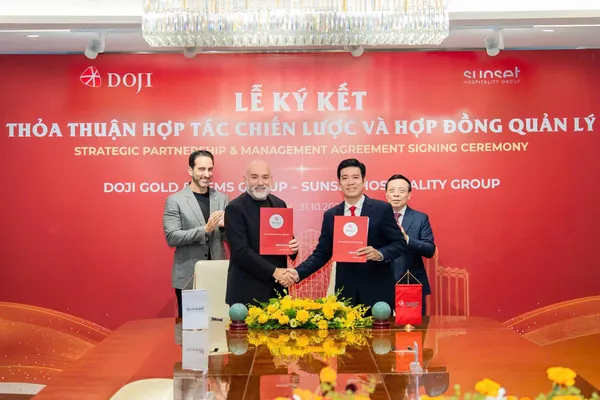

Việt Nam’s Lý Sơn-Sa Huỳnh park could be on its way to becoming a very important place. If the United Nations Educational, Scientific and Cultural Organisation agrees to it, it could become a world geo-park.

|
| Lý Sơn Island, off the coast of Quảng Ngãi Province preserves unique values of archaeology, culture, people and landscape of the ancient volcanoes. |
Việt Nam is moving closer to getting another geo-park recognised by the UN cultural agency UNESCO.
Quảng Ngãi Province, in co-operation with National UNESCO commission of Việt Nam, and archaeologists, scientists and researchers have been completing documents and field surveys to get the status conferred on Lý Sơn-Sa Huỳnh later this year.
The Director of the provincial department of Culture, Sports and Tourism, Nguyễn Minh Trí, said major works and preparations had been finished at a recent conference on the heritage value of Lý Sơn-Sa Huỳnh in Quảng Ngãi City.
“Preparation works including archaeological and geological surveys and evaluations as well as research on ancient cultures started in 2015. We are sure the document will be submitted to UNESCO by late November for approval as a global geo-park site,” Trí, who is also deputy head of the Lý Sơn-Sa Huỳnh geo-park management board, said.
“The Lý Sơn-Sa Huỳnh geo-park has been well preserved with its values of geology, culture and biodiversity on a vast land and sea area of 4,600sq.km including 2,600sq.km of sea area in nine districts and Quảng Ngãi City,” he said.
Research has revealed the value of Lý Sơn Island and of the Sa Huỳnh culture as well as archaeological sites and relics.
Archaeologists and scientists have said that abundant relics related to the Sa Huỳnh, Champa and Đại Việt (or Great Việt) cultures that existed on Lý Sơn Island for thousands of years ago were mostly well-preserved, and ceramic fragments and other antiquities from archaeological excavations in the past revealed the first community living on the island belonged to the Sa Huỳnh culture between 2,500 and 3,000 years ago.
Bùi Văn Liêm, from the Việt Nam Archaeology Institute, said vestiges of the Sa Huỳnh culture were found both in the mainland, sea and islands of the central and central highlands region, and Quảng Ngãi was a centre of the Sa Huỳnh culture.
He said many antiquities related to tombs of the Sa Huỳnh culture had been excavated by Western archaeologists and Vietnamese 110 years ago when the Sa Huỳnh culture was unveiled in 1909.
Liêm said nearly 400 jar tombs were found in the area from 1923.
Dr Andreas Reinecke from the Commission for Archaeology of Non-European Culture of the German Archaeological Institute said he had been working in Southeast Asia since 1993, and most of his field work and excavations were carried out in central and south central Việt Nam.
He said many double headed animal ear-rings belonged to a small group of highly symbolic artefacts of the prehistorical cultures in Southeast Asia which is especially characteristic of the Sa Huỳnh Culture.
“These ear ornaments were mostly found in the jar burials of the ancient periods of this culture with a date before 100 BC. They show the image of sao la – a critically endangered animal found in forests of Nghệ An Province. These ear-rings were worn by shamans of the Sa Huỳnh culture,” Reinecke said.
“Dozens of specimens were found in burials outside Việt Nam and indicate the migration route of Sa Huỳnh communities. The three-pointed stone or glass ear ornaments are more distributed also outside the Sa Huỳnh culture. However, they are also a typical ornament of the Sa Huỳnh culture,” he said.
Phạm Thị Ninh, from the Việt Nam Association of Archaeology, said the existence of communities of the Sa Huỳnh culture related to the coastal area of Việt Nam.
She said at least 2 million fragments of shells and ornaments – which were excavated from the Lý Sơn Island and mainland Quảng Ngãi – unveiled that communities of the Sa Huỳnh culture had lived in the area at least 10,000 years ago.
Đoàn Ngọc Khôi, deputy director of Quảng Ngãi Provincial Museum, said excavations since 2000 on the Lý Sơn Island unearthed axes, chisels, knives and hoes made from stone, bronze and it proved the community of the Sa Huỳnh culture had lived and existed on the islands a long time ago.
Đặng Văn Bài, a member of the National Heritage Council, said the province must strongly commit to protecting the area, and excavations should be preserved at the site following the suggestions of the UN cultural agency.
He said the province should establish a powerful agency to guard the heritage site.
Bài also warned that the province must balance economic growth and heritage conservation.
Deputy Minister of Foreign Affairs Lê Hoài Chung said Lý Sơn-Sa Huỳnh geo-park was considered a priceless heritage of Việt Nam.
Chung, chairman of the national UNESCO Commission of Việt Nam, said he hoped that Lý Sơn-Sa Huỳnh would enter the global geo-park network after the country submitted documents to UNESCO for approval on November 30.
Provincial party secretary Lê Viết Chữ said the province would do what it could to protect the special site.
He said earning UNESCO recognition would require co-operation from different agencies, provinces and experts.
Last year, experts from the Việt Nam Institute of Geosciences and Mineral Resources found a unique complex of fossilised coral believed to date from 4,000 to 6,000 years ago on Lý Sơn Island.
The Director of the Việt Nam Institute of Geosciences and Mineral Resources, Trần Tân Văn, said the institute and the province of Quảng Ngãi would closely co-operate in promoting the archaeological value and culture as a global geo-park site.
Setsuya Nakada, heir of the Advisory Committee of the Global Geo-Park Network, said at least five volcanoes and potentially active volcanoes occurred in central and south Việt Nam in the Neogene-Quaternary (about 30 million years ago).
Lý Sơn Island, known as the "Kingdom of Garlic" in Việt Nam, has about 21,000 inhabitants, of whom 73 per cent make their living from farming garlic and spring onions, alongside fishing. — VNS
GLOSSARY
Quảng Ngãi Province, in co-operation with National UNESCO commission of Việt Nam, and archaeologists, scientists and researchers have been completing documents and field surveys to get the status conferred on Lý Sơn-Sa Huỳnh later this year.
Co-operation means working together.
Archaeologists are people who study and know a lot about the ways of ancient civilisations.
“Preparation works including archaeological and geological surveys and evaluations as well as research on ancient cultures started in 2015.
Geology is the study of rocks. Geological surveys are special studies to do with rocks in a place.
Evaluations are opinions based on facts presented by studies.
We are sure the document will be submitted to UNESCO by late November for approval as a global geo-park site,” Trí, who is also deputy head of the Lý Sơn-Sa Huỳnh geo-park management board, said.
Submitted means “handed in”.
If something receives approval it is accepted because it is considered to be good enough.
“The Lý Sơn-Sa Huỳnh geo-park has been well preserved with its values of geology, culture and biodiversity on a vast land and sea area of 4,600sq.km including 2,600sq.km of sea area in nine districts and Quảng Ngãi City,” he said.
If something is preserved it is kept in its condition.
If there is biodiversity, there are many different types of living things – such as plants and animals – in one place.
Archaeologists and scientists have said that abundant relics related to the Sa Huỳnh, Champa and Đại Việt (or Great Việt) cultures that existed on Lý Sơn Island for thousands of years ago were mostly well-preserved, and ceramic fragments and other antiquities from archaeological excavations in the past revealed the first community living on the island belonged to the Sa Huỳnh culture between 2,500 and 3,000 years ago.
Relics are things left over from the past.
If there are abundant relics, there are many of them.
If something existed it was around at a certain time.
Ceramic fragments are pieces of old pottery.
Antiquities are things from ancient times.
Excavations are diggings where archaeologists look for things to help them know more about ancient civilisations.
Revealed means “showed”.
Bùi Văn Liêm, from the Việt Nam Archaeology Institute, said vestiges of the Sa Huỳnh culture were found both in the mainland, sea and islands of the central and central highlands region, and Quảng Ngãi was a centre of the Sa Huỳnh culture.
Vestiges are things that remind you of the past.
He said many antiquities related to tombs of the Sa Huỳnh culture had been excavated by Western archaeologists and Vietnamese 110 years ago when the Sa Huỳnh culture was unveiled in 1909.
Tombs are places where people who were usually once powerful, are buried.
Unveiled means “announced to the public for the first time”.
He said many double headed animal ear-rings belonged to a small group of highly symbolic artefacts of the prehistorical cultures in Southeast Asia which is especially characteristic of the Sa Huỳnh Culture.
Prehistorical means from very, very long ago.
“These ear ornaments were mostly found in the jar burials of the ancient periods of this culture with a date before 100 BC.”
Ornaments are things that are used to make a person, or a place, look beautiful.
“They show the image of sao la – a critically endangered animal found in forests of Nghệ An Province.”
An animal that is critically endangered is in danger of having all of its kind die out, and therefore become extinct. Once an animal is extinct there are no more of them left in the world.
“These ear-rings were worn by shamans of the Sa Huỳnh culture,” Reinecke said.
Shamans are spiritual people who communicate with spirits.
“Dozens of specimens were found in burials outside Việt Nam and indicate the migration route of Sa Huỳnh communities.
Indicate means “show”.
A migration is a movement of people, or animals, from one place to another.
Đặng Văn Bài, a member of the National Heritage Council, said the province must strongly commit to protecting the area, and excavations should be preserved at the site following the suggestions of the UN cultural agency.
To commit to something means to be dedicated to it.
Setsuya Nakada, heir of the Advisory Committee of the Global Geo-Park Network, said at least five volcanoes and potentially active volcanoes occurred in central and south Việt Nam in the Neogene-Quaternary (about 30 million years ago).
An heir is someone who takes over from someone else.
Potentially active volcanoes are volcanoes that could possibly erupt.
WORKSHEET
Find words that mean the following in the Word Search:
g | t | n | t | a | e | l | n | o | g |
a | e | s | r | n | e | a | o | i | u |
r | b | r | o | a | d | b | v | r | i |
l | g | l | a | s | g | o | e | e | j |
i | r | r | i | a | a | m | m | t | a |
c | u | n | e | s | c | o | b | l | r |
h | h | r | p | r | e | n | e | o | s |
c | o | r | a | l | s | u | r | h | w |
ANSWERS: 1. UNESCO; 2. November; 3. Corals; 4. Garlic; 5. Jar.




